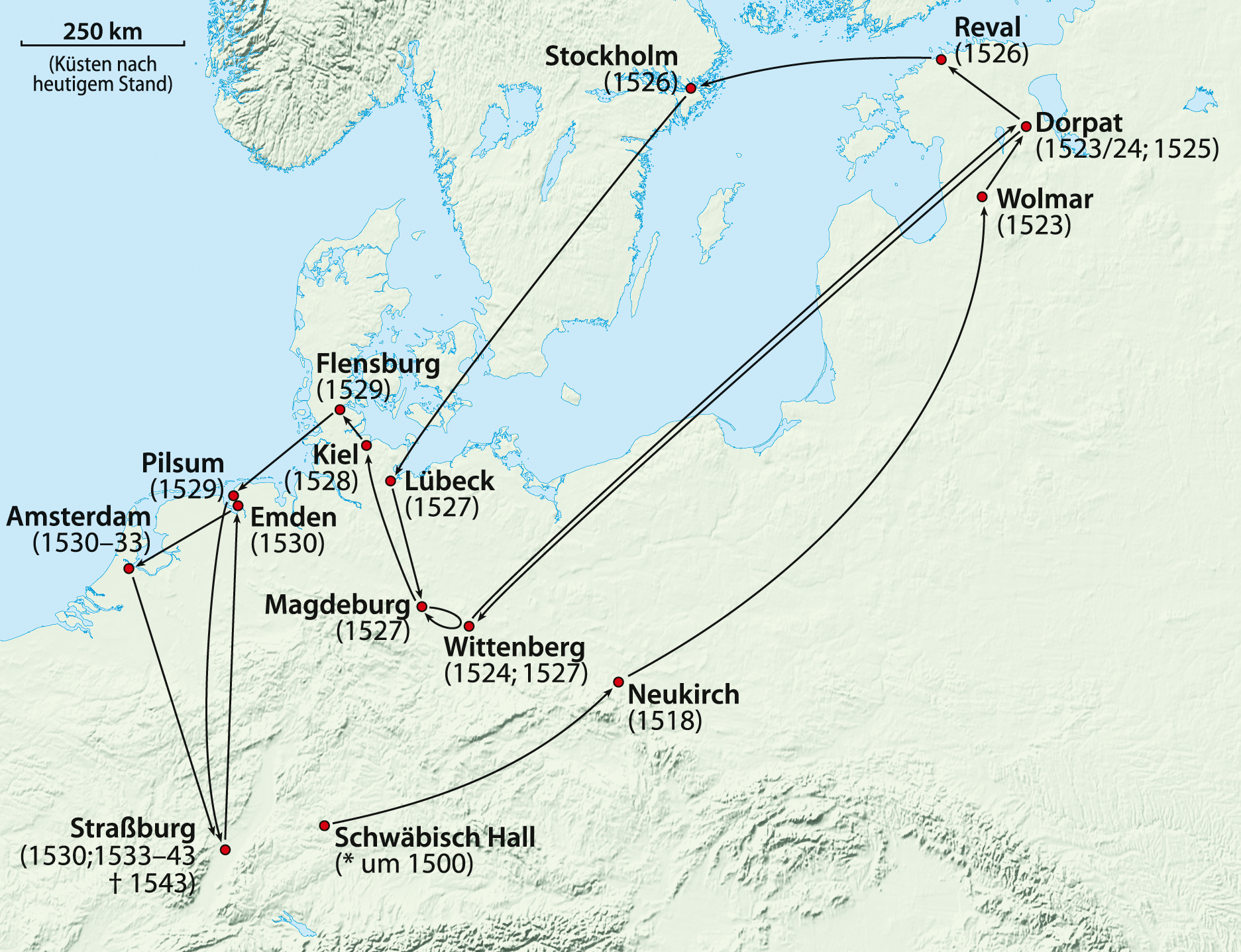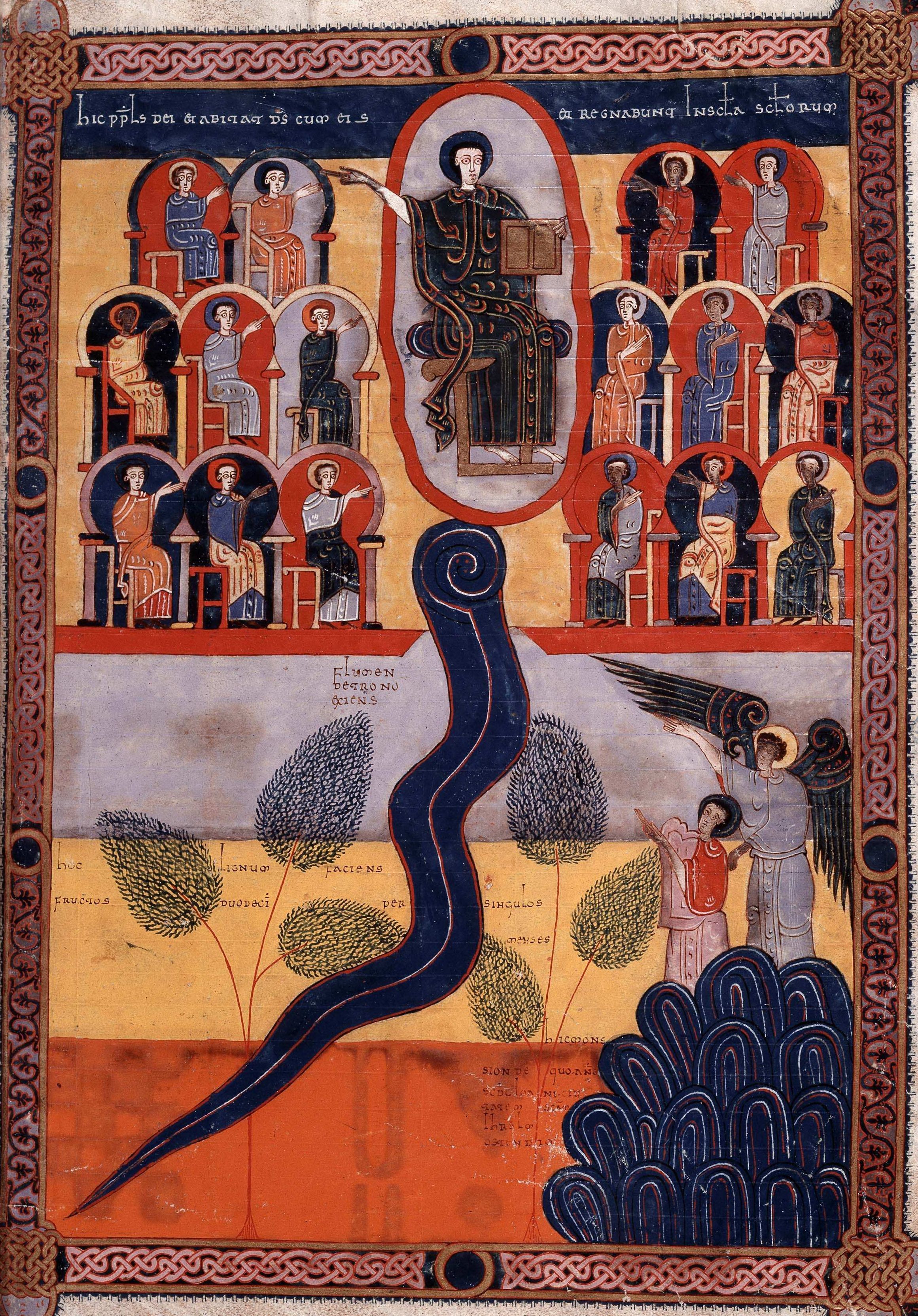|
Melchior Hoffman
Melchior Hoffman (or Hofmann; byname: ''Pel(t)zer'' "furrier"; c. 1495c. 1543) was an Anabaptist prophet and a visionary leader in northern Germany and the Netherlands. Life Hoffman was born at Schwäbisch Hall in southwest Germany before 1500. His biographers usually give his surname as ''Hofmann''; in his printed works it sometimes appears as ''Hoffman'', and in his manuscripts as ''Hoffmann''. He was without scholarly training, and first appeared as a furrier in Livonia. Attracted by Luther's teachings, he came forward as a lay preacher, combining business travels with a religious mission. He worked as a lay preacher in the cities of Wolmar (from 1523), Dorpat and Reval. In Dorpat he became involved in an iconoclastic revolt, and the magistrates obliged him to go to Wittenberg to obtain Luther's approval of his preaching. After his return to Dorpat he was involved in more controversy and forced to leave the city. After the same thing happened in Reval, he decided to go to S ... [...More Info...] [...Related Items...] OR: [Wikipedia] [Google] [Baidu] |
Frederick I Of Denmark
Frederick I (Danish and ; ; ; 7 October 1471 – 10 April 1533) was King of Denmark and Norway. He was the last Roman Catholic monarch to reign over Denmark and Norway, when subsequent monarchs embraced Lutheranism after the Protestant Reformation. As king of Norway, Frederick is most remarkable in never having visited the country and was never crowned as such. Therefore, he was styled ''King of Denmark, the Vends and the Goths, elected King of Norway''. Frederick's reign began the enduring tradition of calling kings of Denmark alternatively by the names Christian and Frederik, which has continued up to the reign of the current monarch, Margrethe II. Background Frederick was the younger son of the first Oldenburg King Christian I of Denmark, Norway and Sweden (1426–81) and of Dorothea of Brandenburg (1430–95). Soon after the death of his father, the underage Frederick was elected co-Duke of Schleswig and Holstein in 1482, the other co-duke being his elder brother, Kin ... [...More Info...] [...Related Items...] OR: [Wikipedia] [Google] [Baidu] |
New Jerusalem
In the Book of Ezekiel in the Hebrew Bible, New Jerusalem (, ''YHWH šāmmā'', YHWH sthere") is Ezekiel's prophetic vision of a city centered on the rebuilt Holy Temple, the Third Temple, to be established in Jerusalem, which would be the capital of the Messianic Kingdom, the meeting place of the twelve tribes of Israel, during the Messianic era. The prophecy is recorded by Ezekiel as having been received on Yom Kippur of the year 3372 of the Hebrew calendar. In the Book of Revelation in the New Testament, the city is also called the Heavenly Jerusalem, as well as being called Zion in other books of the Christian Bible. Judaism and origin In Jewish mysticism, there are two Gardens of Eden and two Promised Lands: the heavenly invisible one and the earthly visible one that is a copy of the heavenly invisible one. Heaven in Jewish mysticism includes a heavenly Promised land - including Jerusalem, the temple, and the ark of the covenant - and a heavenly Garden of Eden - inclu ... [...More Info...] [...Related Items...] OR: [Wikipedia] [Google] [Baidu] |
John Hus
Jan Hus (; ; 1370 – 6 July 1415), sometimes anglicized as John Hus or John Huss, and referred to in historical texts as ''Iohannes Hus'' or ''Johannes Huss'', was a Czech theologian and philosopher who became a Church reformer and the inspiration of Hussitism, a key predecessor to Protestantism, and a seminal figure in the Bohemian Reformation. Hus is considered by some to be the first Church reformer, even though some designate the theorist John Wycliffe. His teachings had a strong influence, most immediately in the approval of a reformed Bohemian religious denomination and, over a century later, on Martin Luther. Hus was a master, dean and rector at the Charles University in Prague between 1409 and 1410. Jan Hus was born in Husinec, Bohemia, to poor parents. In order to escape poverty, Hus trained for the priesthood. At an early age he traveled to Prague, where he supported himself by singing and serving in churches. His conduct was positive and, reportedly, his commitm ... [...More Info...] [...Related Items...] OR: [Wikipedia] [Google] [Baidu] |
Apocalypse
Apocalypse () is a literary genre in which a supernatural being reveals cosmic mysteries or the future to a human intermediary. The means of mediation include dreams, visions and heavenly journeys, and they typically feature symbolic imagery drawn from the Hebrew Bible, cosmological and (pessimistic) historical surveys, the division of time into periods, esoteric numerology, and claims of ecstasy and inspiration. Almost all are written under pseudonyms (false names), claiming as author a venerated hero from previous centuries, as with Book of Daniel, composed during the 2nd century BCE but bearing the name of the legendary Daniel. Eschatology, from Greek ''eschatos'', last, concerns expectations of the end of the present age, and apocalyptic eschatology is the application of the apocalyptic world-view to the end of the world, when God will punish the wicked and reward the faithful. An apocalypse will often contain much eschatological material, but need not: the baptism of J ... [...More Info...] [...Related Items...] OR: [Wikipedia] [Google] [Baidu] |
Emden
Emden () is an independent city and seaport in Lower Saxony in the northwest of Germany, on the river Ems. It is the main city of the region of East Frisia and, in 2011, had a total population of 51,528. History The exact founding date of Emden is unknown, but it has existed at least since the 8th century. Older names for Emden are Setutanda, Amuthon, Embda, Emda, Embden and Embderland. Town privilege and the town's coat of arms, the ''Engelke up de Muer'' (The Little Angel on the Wall) was granted by Emperor Maximilian I in 1495. In the 16th century, Emden briefly became an important centre for the Protestant Reformation under the rule of Countess Anna von Oldenburg who was determined to find a religious "third way" between Lutheranism and Catholicism. In 1542 she invited the Polish noble John Laski (or ''Johannes a Lasco'') to become pastor of a Protestant church at Emden; and for 7 years he continued to spread the new religion around the area of East Frisia. However, ... [...More Info...] [...Related Items...] OR: [Wikipedia] [Google] [Baidu] |
Andreas Karlstadt
Andreas Rudolph Bodenstein von Karlstadt (148624 December 1541), better known as Andreas Karlstadt or Andreas Carlstadt or Karolostadt, or simply as Andreas Bodenstein, was a German Protestant theologian, University of Wittenberg chancellor, a contemporary of Martin Luther and a reformer of the early Reformation. Karlstadt became a close associate of Martin Luther and one of the earliest Protestant Reformers. After Frederick III, Elector of Saxony concealed Luther at the Wartburg (1521–1522), Karlstadt and Thomas Müntzer started the first iconoclastic movement in Wittenberg and preached theology that was viewed as Anabaptist, but Karlstadt and Müntzer never regarded themselves as Anabaptists. Karlstadt operated as a church reformer largely in his own right, and after coming in conflict with Luther, he switched his allegiance from the Lutheran to the Reformed camp, and later became a radical reformer before once again returning to the Reformed tradition. First, he serve ... [...More Info...] [...Related Items...] OR: [Wikipedia] [Google] [Baidu] |
Kaspar Schwenkfeld
Caspar (or Kaspar) Schwen(c)kfeld von Ossig () (1489 or 1490 – 10 December 1561) was a German theologian, writer, physician, naturalist, and preacher who became a Protestant Reformer and spiritualist. He was one of the earliest promoters of the Protestant Reformation in Silesia. Schwenckfeld came to Reformation principles through Thomas Müntzer and Andreas Karlstadt. However, he developed his own principles and fell out with Martin Luther over the eucharistic controversy (1524). He had his own views on the sacraments - the Heavenly Flesh doctrine - developed in close association with his humanist colleague, Valentin Crautwald (1465–1545). His followers became a new sect (''see Schwenckfelders''), which was outlawed in Germany, but his ideas influenced Anabaptism, Pietism on mainland Europe, and Puritanism in England. Many of his followers were persecuted in Europe and thus forced to either convert or flee. Because of this, there are Schwenkfelder Church congregations ... [...More Info...] [...Related Items...] OR: [Wikipedia] [Google] [Baidu] |
East Frisia
East Frisia or East Friesland (german: Ostfriesland; ; stq, Aastfräislound) is a historic region in the northwest of Lower Saxony, Germany. It is primarily located on the western half of the East Frisian peninsula, to the east of West Frisia and to the west of Landkreis Friesland. Administratively, East Frisia consists of the districts Aurich, Leer and Wittmund and the city of Emden. It has a population of approximately 469,000 people and an area of . There is a chain of islands off the coast, called the East Frisian Islands (''Ostfriesische Inseln''). From west to east, these islands are: Borkum, Juist, Norderney, Baltrum, Langeoog and Spiekeroog. History The geographical region of East Frisia was inhabited in Paleolithic times by reindeer hunters of the Hamburg culture. Later there were Mesolithic and Neolithic settlements of various cultures. The period after prehistory can only be reconstructed from archaeological evidence. Access to the early history of East Fris ... [...More Info...] [...Related Items...] OR: [Wikipedia] [Google] [Baidu] |
Strasbourg
Strasbourg (, , ; german: Straßburg ; gsw, label=Bas Rhin Alsatian, Strossburi , gsw, label=Haut Rhin Alsatian, Strossburig ) is the prefecture and largest city of the Grand Est region of eastern France and the official seat of the European Parliament. Located at the border with Germany in the historic region of Alsace, it is the prefecture of the Bas-Rhin department. In 2019, the city proper had 287,228 inhabitants and both the Eurométropole de Strasbourg (Greater Strasbourg) and the Arrondissement of Strasbourg had 505,272 inhabitants. Strasbourg's metropolitan area had a population of 846,450 in 2018, making it the eighth-largest metro area in France and home to 14% of the Grand Est region's inhabitants. The transnational Eurodistrict Strasbourg-Ortenau had a population of 958,421 inhabitants. Strasbourg is one of the ''de facto'' four main capitals of the European Union (alongside Brussels, Luxembourg and Frankfurt), as it is the seat of several European insti ... [...More Info...] [...Related Items...] OR: [Wikipedia] [Google] [Baidu] |
John Campanus
Johann Campanus (also Johannes Campanus) was a Flemish religious reformer of the sixteenth century. In his ''Autobiographical Letter to Johann Campanus'' (1531), a public Latin epistle, Sebastian Franck exhorted Campanus to maintain freedom of thought in face of the charge of heresy. As a preacher, Campanus knew the Anabaptist prophet Melchior Hoffman (c.1495–1543). Hoffman had developed a Zwinglian view of the Eucharist. Martin Luther himself was alarmed at this. At a colloquy of preachers in Flensburg on 8 April 1529, Hoffman, Campanus, and others were put on the defensive. Hoffman maintained (against the "magic" of the Lutheran interpretation) that the function of the Eucharist, like that of preaching, is nothing more than an appeal for spiritual union with Christ Jesus, likely from he, יֵשׁוּעַ, translit=Yēšūaʿ, label=Hebrew/Aramaic ( AD 30 or 33), also referred to as Jesus Christ or Jesus of Nazareth (among other names and titles), was a first-cen ... [...More Info...] [...Related Items...] OR: [Wikipedia] [Google] [Baidu] |









